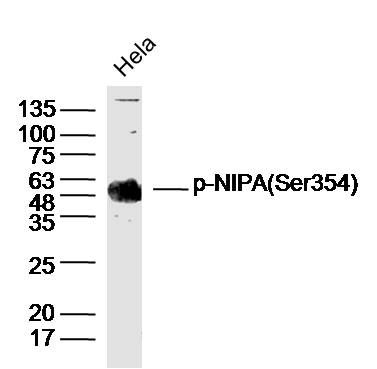The regulated oscillation of protein expression is an essential mechanism of cell cycle control. The SCF class of E3 ubiquitin ligases is involved in this process by targeting cell cycle regulatory proteins for degradation by the proteasome, with the F-box subunit of the SCF specifically recruiting a given substrate to the SCF core. NIPA (nuclear interaction partner of ALK) is a human F-box-containing protein that defines an SCF-type E3 ligase (SCFNIPA) controlling mitotic entry. Assembly of this SCF complex is regulated by cell-cycle-dependent phosphorylation of NIPA, which restricts substrate ubiquitination activity to interphase. Nuclear cyclin B1 is a substrate of SCFNIPA. Inactivation of NIPA by RNAi results in nuclear accumulation of cyclin B1 in interphase, activation of cyclin B1-Cdk1 kinase activity, and premature mitotic entry. Thus, SCFNIPA-based ubiquitination may regulate S-phase completion and mitotic entry in the mammalian cell cycle.
Function:
Essential component of an SCF-type E3 ligase complex, SCF(NIPA), a complex that controls mitotic entry by mediating ubiquitination and subsequent degradation of cyclin B1 (CCNB1). Its cell-cycle-dependent phosphorylation regulates the assembly of the SCF(NIPA) complex, restricting CCNB1 ubiquitination activity to interphase. Its inactivation results in nuclear accumulation of CCNB1 in interphase and premature mitotic entry. May have an antiapoptotic role in NPM-ALK-mediated signaling events.
Subunit:
Interacts with the NPM-ALK fusion protein in a tyrosine phosphorylation-dependent manner. Interacts with SKP1. Component of a SCF(NIPA) E3 complex with SKP1, RBX1 and CUL1 when not phosphorylated on Ser-354. Interacts with CCNB1.
Subcellular Location:
Nuclear.
Tissue Specificity:
Widely expressed. Highly expressed in heart, skeletal muscle and testis. Expressed in brain, placenta, lung, kidney, liver, pancreas, spleen, thymus, prostate, ovary small intestine and colon. Weakly or not expressed in leukocytes.
Post-translational modifications:
hosphorylated. Phosphorylated on Ser residues at G2/M phase, but not during S and G0 phases. May also be weakly phosphorylated on Tyr residues. Ser-354 phosphorylation, a major site during the course of cell-cycle-dedendent phosphorylation, results in its dissociation from the SCF(NIPA) complex, thereby preventing CCNB1 degradation leading to mitotic entry.
Similarity:
Contains 1 C3HSLCtype zinc finger.
SWISS:
Q86WB0
Gene ID:
51530
Database links:
Entrez Gene: 51530 Human
Entrez Gene: 232679 Mouse
Entrez Gene: 296957 Rat
SwissProt: Q86WB0 Human
SwissProt: Q80YV2 Mouse
Unigene: 194157 Human
Unigene: 29780 Mouse
Unigene: 474686 Mouse
| Picture |
Sample:
Hela Cell(Human)Lysate at 30 ug
Primary: Anti- p-NIPA(Ser354) (SL8364R)at 1/300 dilution
Secondary: IRDye800CW Goat Anti-Rabbit IgG at 1/20000 dilution
Predicted band size: 55kD
Observed band size: 55kD
|
|
|
